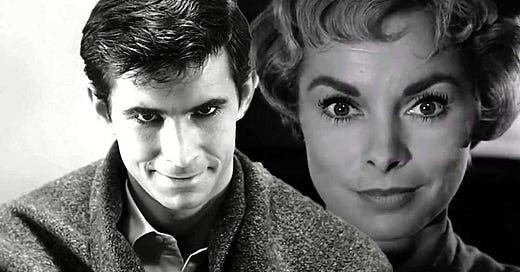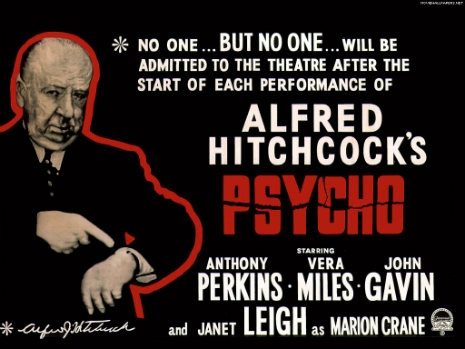SPOILERS BEWARE! As this month is the 65th anniversary of the release of Psycho and the 45th anniversary of Friday 13th I thought it would be cool to explore the bloody origins of the slasher movie. From a humble 1960’s black and white chiller to the technicolour blood washed movies of Friday the 13th and beyond.
So where did it all start?
Hollywood director, Alfred Hitchcock wanted to make a film based on a 1959 book called Psycho by Robert Bloch. Loosely based on the real life serial killer Ed Gein, who had a infatuation with his mother and an obsessive interest in taxidermy.
Paramount Pictures didn’t want him to make the movie believing it to be a sleazy horror film and deferred almost all the rights to Hitchcock, thinking in doing so would stop the director from making the film.
But Hitchcock financed most of the movie himself in return for a large cut of the profits. He kept the costs down by shooting in black and white and using many of the crew that worked on his TV show, ‘Alfred Hitchcock Presents.’
Arguably the most famous if not the most famous murder scene in movie history is the shower scene with Janet Leigh.
At the time she was a ‘A List’ star and the story makes her out to be the leading lady in this film. So its truly shocking that her character is killed off so early in the movie. Through great editing the knife doesn’t penetrate the skin (apart from one frame), leaving the audience to use their imagination and avoid the wrath of the film censors.
Hitchcock tried to use fake blood for this scene but it didn’t look right in black and white. So chocolate syrup was used as it looked more vivid.
Anthony Perkins, who played Norman Bates was not even present during this iconic scene as he was involved in a theatre tour at the time, so a stand in was used instead.
Originally Hitchcock didn’t want any music during the shower scene but Bernard Hermann came up with the now iconic string score which the director eventually used and this music has now become synonymous with this scene and is considered a land mark achievement in film scoring according to Film Independent.
Violins, violas and cellos screech during each slash of the knife giving it a shocking and terrifying element racking up the tension even more.
Hitchcock on his movies tended not to allow his actors to improvise, famously saying they should be ‘treated like cattle.’ He would normally give them specific direction and expect the actors to follow his directions, using them as clay to mould into his masterpiece.
But in this movie he allowed the actors to improvise something unprecedented in a Hitchcock movie. Perkins and Leigh were allowed more room to flex their acting muscles and as a result the characters feel more real and relatable.
An example of this is Norman constantly chewing candy corn. As the net closes in on him his jaw nervously moves, betraying his cool exterior. This was Perkins’ own idea and Hitchcock loved it so much that he kept it in.
One of the movie’s enduring legacies is the use of performance times. This movie changed the way we see films at the cinema.
Before Psycho, movies were often a double or triple feature and put on a loop. People would turn up at the beginning, middle or end of one feature and leave once they’ve seen the first part of the other film that they had missed.
Hitchcock needed this to change as his new movie was designed to shock and surprise the audience and this couldn’t be achieved if people turned up at any time.
He got the cinemas to implement scheduled screening times so, ”that everyone else in the world would enjoy the fruits of my labours to the full by seeing the picture from beginning to end. This was the way the picture was conceived - and this was how it had to be seen,” Hitchcock told Motion Picture Herald at the time.
Cinemas were reluctant at first but Hitchcock was insistent and they eventually agreed.
Loudspeakers and posters had Hitchcock declaring no one would be allowed into the cinema once the film had started and the doors would be locked. Not even the President of the United States or The Queen of England (God bless her)! Hitchcock was shown conveying the same message in newspaper ads and hired uniformed security guards to enforce the rules outside cinemas.
The advertising campaign was a success and the face of cinema would never be the same again.
In order to keep the plot twists under wraps no trailers showed a single frame of the movie and Perkins and Leigh were banned from doing interviews. He banned any critical pre-screenings and even got his assistant to buy up as many copies of Bloch’s novel as they could to avoid any spoilers.
The Movie cost $806,947 to make and made $32 million at the box office. As Hitchcock had put up most of the money himself and Paramount had agreed he could take a larger share of the box office takings because of this, he made a substantial amount of money from it.
In Part 2 next Friday I will be covering John Carpenter’s Halloween.
If you liked this please like, share or comment.
Feel free to buy me a coffee to show your appreciation.
Presently all my writing is FREE but if you would like to keep me in black coffee and chocolate biscuits feel free to become a paid subscriber (£3.50 per month/£30 per year) and get that warm fuzzy feeling of helping a struggling writer to keep the lights on.
Jason Duck- A Writer's Journey is a reader-supported publication. To receive new posts and support my work, consider becoming a free or paid subscriber.





